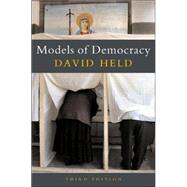
Models of Democracy
by Held, DavidBuy New
Rent Textbook
Rent Digital
Used Textbook
We're Sorry
Sold Out
Summary
Author Biography
Table of Contents
| List of Figures and Tables | |
| Preface | |
| Introduction | |
| Classic Models | |
| Classical Democracy: Athens | |
| Political ideas and aims | |
| Institutional features | |
| The exclusivity of an ancient democracy | |
| The critics | |
| In sum: Model I | |
| Republicanism: Liberty, Self-Government and the Active Citizen | |
| The eclipse and re-emergence of homo politicus | |
| The reforging of republicanism | |
| Republicanism, elective government and popular sovereignty | |
| From civic life to civic glory | |
| In sum: Model IIa | |
| The republic and the general will | |
| In sum: model IIb | |
| The public and the private | |
| The Development of Liberal Democracy: For and Against the State | |
| Power and Sovereignty | |
| Citizenship and the Constitutional State | |
| Separation of Powers | |
| The problem of factions | |
| Accountability and Markets | |
| In sum: model IIIa | |
| Liberty and the development of democracy | |
| The dangers of despotic power and an overgrown state | |
| Representative government | |
| The subordination of women | |
| Competing conceptions of the lsquo;ends of governmentrsquo | |
| In sum: Model IIIb | |
| Direct Democracy and the End of Politics | |
| Class and class conflict | |
| History as evolution and the development of captialism | |
| Two theories of the state | |
| The end of politics | |
| Competing conceptions of Marxism | |
| Recent Variants | |
| Competitive ELitism and the Technocratic Vision | |
| Classes, power and conflict | |
| Bureaucracy, parliaments and nation-states | |
| Competitive elitist democracy | |
| Liberal democracy at the crossroads | |
| The last vestige of democracy? | |
| Democracy, capitalism and socialism | |
| lsquo;Classicalrsquo; v. modern democracy | |
| A technocratic vision | |
| In sum: model V | |
| Pluralism, Corporate Capitalism and the State | |
| Group politics, government and power | |
| Politics, consensus and the distribution of power | |
| Democracy, corporate capitalism and the state | |
| In sum: Model VI | |
| Accumulation, legitimation and the restricted sphere of the political | |
| The changing form of representative institutions | |
| From Post-War Stability to Political Crisis: The Polarization of Political Ideas | |
| A legitimate democratic order or a repressive regime? | |
| Overloaded state or legitimation crisis? | |
| Crisis theories: an assessment | |
| Law, liberty and democracy | |
| In sum: model VII | |
| Participation, liberty and democracy | |
| In sum: model VII | |
| Democracy after Soviet Communism | |
| The historical backdrop | |
| The triumph of economic and political liberalism | |
| The renewed necessity of Marxism and democracy from lsquo;belowrsquo;? | |
| Deliberative Democracy and the Defence of Public Reason | |
| Reason and Participation | |
| The limits of democratic theory | |
| The aims of deliberative democracy | |
| What is sound about public reasoning? Impartialism and itrsquo;s critics | |
| Institutions of deliberative democracy | |
| Value pluralism and democracy | |
| In sum: Model IX | |
| Table of Contents provided by Publisher. All Rights Reserved. |
An electronic version of this book is available through VitalSource.
This book is viewable on PC, Mac, iPhone, iPad, iPod Touch, and most smartphones.
By purchasing, you will be able to view this book online, as well as download it, for the chosen number of days.
Digital License
You are licensing a digital product for a set duration. Durations are set forth in the product description, with "Lifetime" typically meaning five (5) years of online access and permanent download to a supported device. All licenses are non-transferable.
More details can be found here.
A downloadable version of this book is available through the eCampus Reader or compatible Adobe readers.
Applications are available on iOS, Android, PC, Mac, and Windows Mobile platforms.
Please view the compatibility matrix prior to purchase.
